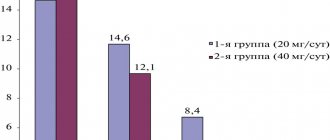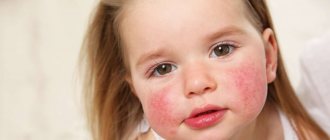Chronic urticaria: drug of choice
XP
onic idiopathic urticaria (IU) is a skin disorder that affects 0.1–3% of the population. CHI usually affects people of working age, since the onset of the disease often occurs in the second and fourth decades of life, with at least one episode of urticaria occurring throughout life in 15–20% of both children and adults. Chronic urticaria is diagnosed twice as often in middle-aged women, which is due to the presence of dishormonal and neuroendocrine disorders [1, 2]. In approximately 50% of patients, chronic urticaria is combined with Quincke's edema [3]. In patients with CIC, the quality of life is significantly impaired, which is expressed in sleep disturbances, changes in the emotional background, and the occurrence of certain problems in everyday life [4, 5]. Urticaria can be either an independent disease or a symptom of a number of diseases. Clinical manifestations of urticaria are the result of the release and synthesis of mediators, mainly by mast cells located in the skin, which is caused by immune, non-immune, and idiopathic factors. The primary element in urticaria is a blister - urtica. When pressed, the urticarial element turns pale, which indicates the presence of dilated blood vessels and edema in the skin lesions. Urticarial rash is accompanied by itching, which intensifies at night and lasts from a few minutes to 48 hours [6]. After a specified period, the elements of the rash disappear without a trace, however, new rashes may appear at different times in other parts of the body (Fig. 1) [7]. At the histological level, it is swelling and perivascular infiltration of lymphocytes, mast cells, eosinophils and neutrophils of the epidermis and upper layer of the dermis with compression of veins and lymphatic vessels. Urticaria and Quincke's edema can develop together or separately. If the swelling involves the skin and subcutaneous tissue, the condition is called angioedema, or angioedema. With urticaria, only the superficial layers of the skin are involved in the process. With Quincke's edema, the itching is less pronounced, but the pain and burning sensation are similar. Urticaria can occur on any part of the body, while angioedema occurs most often in areas rich in connective tissue, such as the face, limbs and genitals. Unlike other forms of edema, there is no symmetry in its location (Fig. 2) [8].
There are acute (up to 6 weeks) and chronic (more than 6 weeks) urticaria. When rashes appear repeatedly, recurrent urticaria is diagnosed. Urticaria is most often associated with food and drug allergies, and can also be mediated by helminthic infestation or viral infection. Moreover, in half of the patients the cause of the urticarial rash cannot be identified - such urticaria is designated as idiopathic. It was previously believed that urticaria was mostly idiopathic, accounting for 80–95% of all urticaria cases. In the literature of recent years, the name “idiopathic urticaria” has become less and less common; the term “chronic urticaria” has become more common, since during many years of observation of patients with a previously established diagnosis of “idiopathic urticaria”, many researchers identified an autoimmune genesis in 35-55% of cases [7, 8]. Chronic urticaria can also be mediated by parasites, which is explained by their stimulating role in the development of the IgE immune response, however, clinical resolution of urticaria by eliminating parasites is achieved only in 8–16% of cases [9]. One of the reasons for increased activation of mast cells in patients with chronic urticaria is often identified infectious and inflammatory pathology of the digestive tract. Helicobacter pylori infection has also been implicated in chronic urticaria. It has been established that the frequency of its detection among patients with urticaria and in the population is the same. However, the immune response to H. pylori may differ in patients with urticaria. Moreover, an analysis of existing studies revealed that remission of urticaria is more likely in cases where antibacterial therapy leads to eradication of H. pylori [10]. In some patients, a combination of chronic urticaria with autoimmune pathology of the thyroid gland was found, accompanied by the detection of antithyroid antibodies in the serum, which may be a marker of an autoimmune nature, however, the mechanisms of the connection of antithyroid autoantibodies with mast cell activation remain unclear [11]. With CIC, urticarial elements persist longer than with various types of physical urticaria - usually up to 8-12 hours and are accompanied by more severe itching, especially in the evening and at night. With CIC, 25–45% of patients show signs of an autoimmune disease. In such patients, the level of serum immunoglobulin E (IgE) is significantly lower, and severe itching is added to the abundant and widespread urticarial rash [12]. When examining skin biopsies in patients with CIC and the presence of FcεRI/IgE antibodies, perivascular infiltrates are often detected, mainly consisting of neutrophils, eosinophils and mononuclear cells [13, 14]. Almost a third of patients with CIC have autoimmune reactions to thyroid tissue. However, most of them do not have any clinical symptoms of damage to the thyroid gland and changes in hormone levels; there is a decrease or disappearance of urticaria symptoms after the administration of L-thyroxine [11, 14–16]. In addition to assessing the history, clinical symptoms of the disease and its course, laboratory tests help in the differential diagnosis of chronic urticaria: • skin tests or determination of specific IgE antibodies in the blood can reveal the connection of the rash with food, medications, insect bites, plant pollen, animals; • sowing in the presence of a chronic focus of inflammation to isolate a culture of bacteria and determine their sensitivity; • study of thyroid function; • stool analysis for helminth eggs; • tests for the presence of autoantibodies; • complete blood count, ESR, determination of C-reactive protein; • detection of H. pylori [17] . The main drugs in the treatment of chronic urticaria are antihistamines. Despite the fact that first generation antihistamines (diphenhydramine, hydroxyzine, etc.) effectively eliminate the symptoms of urticaria, their use is associated with a large number of side effects. These include drowsiness, anticholinergic effect (dry mucous membranes, dizziness, constipation, urinary retention, etc.), impaired memory and attention, which can persist for 24 hours after taking the drug. According to the International Guideline for the Treatment of Urticaria (EAACI/GA2LEN/EDF/WAO management guideline), first generation antihistamines (sedatives) should not be used as first-line treatment for patients with urticaria. The only exceptions can be those situations when it is impossible to use second generation antihistamines. Currently, the priority is to prescribe non-sedating antihistamines of the second generation. These drugs, devoid of the side effects inherent in first-generation antihistamines, are no less effective at blocking H1 receptors for histamine and suppressing the symptoms of urticaria, significantly improving the quality of life of patients [18, 19]. Among the “non-sedating” antihistamines, desloratadine (Elysea), which is the primary pharmacologically active metabolite of the well-known loratadine, deserves special attention. Desloratadine is a drug that enters the body in the form of an active substance, which ensures its higher safety profile. It was synthesized in 1998 and registered in Russia in 2001. Desloratadine has the ability to suppress the acute phase of the allergic response by blocking H1 receptors. In experimental studies, it was shown that desloratadine has the greatest affinity for H1-histamine receptors and slow dissociation from connection with them. Desloratadine binds noncompetitively to H1 receptors and, according to clinical studies, has 52, 57, 194 and 153 times higher activity than cetirizine, ebastine, fexofenadine and loratadine, respectively. The drug is rapidly absorbed after oral administration and is characterized by a high rate of achievement of maximum plasma concentration and a rapid onset of action (after 1.25–3.00 hours). The pharmacokinetics of desloratadine are linear and dose proportional. The half-life of the drug is 21–24 hours, which allows it to be administered once a day. Eating does not affect the rate and degree of absorption of the drug. It was found that the pharmacokinetics and bioavailability of desloratadine are the same when taking the drug on an empty stomach and after a standardized meal in healthy people (the maximum concentration on an empty stomach and after a meal was 3.30 and 3.53 ng/ml, respectively, p = 0.17). Consequently, the drug can be taken regardless of meals, which indicates the convenience of its use. Metabolism and excretion of the drug do not depend on the age and gender of the patient [20–24]. Animal studies in vitro and in vivo have demonstrated that desloratadine, by inhibiting a number of inflammatory mediators, has additional antiallergic and anti-inflammatory effects not associated with blockade of H1-histamine receptors. At physiological concentrations, the drug effectively inhibits the production of histamine-dependent proinflammatory cytokines - IL-6 and IL-8, which are known to be released from endothelial cells, basophils and mast cells, and stimulate the secretion of proinflammatory mediators, such as tumor necrosis factor α. Desloratadine affects the activation and survival of eosinophils. Eosinophils, being the key effector cells in the allergic reaction, produce cytokines, chemokines, leukotrienes and neuromodulators. In addition, desloratadine, through inverse agonism, reduces the expression of nuclear factor κB (NF-κB), known as an inducer of RANTES, a major attractant for eosinophils, monocytes and T lymphocytes, promoting eosinophil activation and histamine release from basophils. Desloratadine is more potent than other antihistamines in inhibiting the activity of NF-κB, which stimulates the release of proinflammatory mediators from basophils and mast cells. In this effect, the drug is superior to cetirizine, loratadine and fexofenadine. Recent studies have shown that desloratadine may also inhibit mast cell degranulation and subsequent histamine release. In addition, desloratadine inhibits histamine-induced P-selectin expression [25–27]. Desloratadine is characterized by a high level of safety when used. It does not cause negative changes in the cardiovascular system and other organs, does not have a hypnotic effect and does not affect cognitive functions. The drug can be used by patients with pathologies of the hepatobiliary system and kidney diseases, and is approved for use in children from 1 year of age [23, 24]. Among the second generation antihistamines, desloratadine stands out for its more than 15 years of successful experience in widespread medical use and a large evidence base. The effectiveness and safety of desloratadine in the treatment of patients with CIC has been proven by numerous randomized, placebo-controlled clinical studies. J. Ring, R. Hein, A. Gauger conducted a multicenter, double-blind, placebo-controlled study that included 190 patients with moderate to severe CIC. During exacerbation of the disease, the 1st group of patients was prescribed desloratadine 5 mg/day, the 2nd group - placebo (control). The duration of treatment reached 6 weeks. The primary efficacy criterion was the average change in the itching index during the first 7 days of treatment compared to baseline. It was found that during the 1st week in patients receiving desloratadine, the itching index decreased by 56%, and in the control group - by 22%; a more rapid regression of skin rashes was also noted than in the control group. It was found that in patients from group 1 at the end of the 1st week of treatment, the degree of sleep disturbance when using the drug decreased by 53%, and in patients from group 2 - only by 18%. After 6 weeks During treatment with the drug, the itching index decreased by 74%, and during treatment with placebo – by 48.7%. By the end of the study, patients taking desloratadine experienced an almost 80% reduction in sleep disturbance. Both patients and doctors highly appreciated the overall positive dynamics of CIC symptoms and the response to treatment with desloratadine. The frequency of adverse events was comparable in the 2 groups; no serious adverse reactions were recorded [28]. In a more recent study, 137 patients with moderate to severe CIC were randomized into 2 groups. Patients from group 1 were prescribed desloratadine 5 mg/day, and patients from group 2 were prescribed placebo for 6 weeks. By the end of the study, the itching index in the desloratadine group decreased by 1.43, and in the placebo group by 0.86 (p = 0.004). After 6 weeks the number of patients with a complete, significant or moderate response to treatment was higher in the group of patients receiving desloratadine compared to patients receiving placebo (68.8 and 36.8%, respectively). No serious adverse events were reported, and the incidence of any adverse reactions was 11.1% in the placebo group and 6.2% in the desloratadine group [29]. Another study showed that desloratadine reduced the severity of the main clinical symptoms of CIC, primarily pruritus, by 50–70%. The effect of the drug lasted up to 24 hours. A decrease in symptoms of itching at the end of the desloratadine dosing interval was observed in 45% of patients (versus 4% of those taking placebo) and after 6 weeks. admission - 69%. There was also a significant decrease in the size and number of blisters during long-term use of desloratadine. Patients noted an 80% improvement in sleep. Assessment of the quality of life in patients with CIC while taking the drug for 7 days showed a decrease in scores on the Dermatology Life Quality Index (DLQI) questionnaire from 13.4 to 9.1. In 60% of patients during the specified period, the DLQI index decreased by an average of 2 points. By the end of the study, the proportion of such patients reached 77% (p<0.0001) [30]. In Germany in 2001–2002. 77,800 patients over 12 years of age were examined. Symptoms of allergic diseases were assessed before and after treatment. As a result of treatment with desloratadine, the vast majority of patients experienced relief of symptoms, which indicated a pronounced clinical effect [31]. A clinical study involving 12,050 patients confirmed the high therapeutic efficacy of desloratadine in CIC. At the same time, the absence of sedative influence and preservation of psychomotor functions were noted [32]. A number of studies were also carried out in Russia under the leadership of Yu.V. Sergeeva, N.V. Kungurova, I.M. Korsunskaya et al., aimed at assessing the effectiveness of desloratadine in the treatment of various dermatoses accompanied by itching. Therapy with desloratadine gave a positive effect in the form of a reduction in itching or its complete regression in 90% of patients. No side effects were observed during treatment with desloratadine [33–35]. Desloratadine meets all ARIA/EAACI criteria and is recommended as the first line of treatment for allergic dermatoses [36, 37]. It has special pharmacokinetic properties: it is quickly absorbed, its bioavailability is not affected by food or juice intake. The half-life of desloratadine is 21–27 hours, which allows its therapeutic activity to remain unchanged when taken once a day (unlike other second-generation antihistamines). Moreover, a study of the compatibility of desloratadine with other drugs did not reveal any significant interactions. A distinctive feature of desloratadine from other second-generation antiallergic drugs is its triple mechanism of action: it not only blocks H1-histamine receptors, but also has pronounced antiallergic and anti-inflammatory activity by inhibiting the synthesis of many other mediators by mast cells, basophils and other cells involved in the development of inflammation [ 38]. Desloratadine inhibits the development of not only the early, but also the late phase of the allergic reaction, which is associated with the accumulation of “inflammatory cells” in the lesion. This unique pharmacological effect of desloratadine suppresses the formation of chronic inflammation, which, in the absence of adequate therapy, can lead to a protracted course of the disease. Additional confirmation of the anti-inflammatory activity of desloratadine, associated with the suppression of not only allergic inflammation, is its ability to inhibit the development of erythema when exposed to ultraviolet B-range radiation [39]. The clinical efficacy and safety of desloratadine for chronic urticaria has been proven in multicenter, randomized, placebo-controlled, double-blind studies. Efficacy in suppressing itching was observed from the first day of use of the drug and persisted over the next 6 weeks. In addition, treatment with desloratadine led to the elimination or significant reduction in the severity of symptoms of CIC such as sleep disturbances, decreased activity and performance of patients. There were no side effects [40]. One of the drugs widely used in clinical practice is Elisea (desloratadine 5 mg). Since chronic urticaria is a long-term and recurrent disease, the drug is beneficial from a pharmacoeconomic position. It has antiallergic, antipruritic and antiexudative effects. Effective relief of urticaria symptoms when prescribing Elisea at a dosage of 5 mg occurs already on the first day of treatment, continues throughout the entire period of use of the drug and consists of a rapid and persistent reduction of rash, itching, improved sleep and activity of patients during the daytime, i.e. the use of Elisea for chronic urticaria is accompanied by a significant improvement in the quality of life of patients. Elisea has virtually no sedative effect, the drug does not affect cognitive functions (reading, driving). Elisey is prescribed from the age of 12, at a dosage of 5 mg (1 tablet), once a day, regardless of meals. The duration of treatment depends on the severity and form of urticaria. The high degree of safety and good tolerability give reason to recommend Elisey for the treatment of patients suffering from chronic urticaria.
Classification
Modern classifications of urticaria are based on the duration of symptoms of the disease, the reasons for its development and take into account the influence of trigger factors [1, 2]. Thus, acute urticaria is defined as the recurrent appearance of blisters with or without angioedema for no more than 6 weeks. Chronic urticaria recurs for more than 6 weeks. Moreover, in approximately 10–20% of cases, angioedema may be the first and only manifestation of urticaria. About 60% of patients with chronic spontaneous urticaria report episodes of angioedema [3]. In addition to manifestations on the skin, urticaria may be accompanied by pain, swelling of the joints (55.3%), headache/general malaise (47.6%), feeling of heat (42.7%), wheezing or shortness of breath (30.1%), gastrointestinal disorders (26.2%), rapid heartbeat (9.7%) [4].
Urticaria is divided into spontaneous or chronic induced. The group of induced urticaria includes forms of the disease that developed under the influence of physical factors (dermographic, thermal, cold, solar, vibration), as well as non-physical triggers (cholinergic, contact and aquagenic) [2].
Epidemiology
Data on the prevalence of chronic spontaneous urticaria vary somewhat. The lifetime risk of developing an episode of urticaria in the average population is thought to be between 20 and 25%. At the same time, searching for a potential allergen that caused the development of urticaria is a difficult task, despite significant advances in the development of modern laboratory diagnostics. Thus, in 20% of cases, the development of acute urticaria is associated with exposure to potential exogenous allergens, such as food or drugs. In 30% of cases, urticaria is caused by infectious agents, especially respiratory tract infections. However, the causes of the remaining 50% of urticaria cases remain unclear [5].
On average, chronic urticaria is reported in approximately 1% of individuals in the population [6]. Moreover, women get sick almost 2 times more often than men, and the onset of the disease most often occurs in the 3rd–5th decades of life [6]. Among the main risk factors for the development of chronic urticaria are obesity, anxiety, dissociative and somatoform disorders, and malignant neoplasms [7].
Diagnostics
Usually, external examination is sufficient to identify urticaria. To select the most effective medicine, the doctor asks the patient about the location, frequency, duration of the rash, and possible causes. If an allergic nature of the disease is suspected, allergy tests are prescribed. If the cause of the rash is not an allergy, then the patient requires a comprehensive examination. During it the following may be carried out:
- blood biochemistry and general analysis,
- Analysis of urine,
- tests for sexually transmitted infections, syphilis, herpes,
- Ultrasound of internal organs,
- gastroscopy,
- electrocardiogram and other studies.
Treatment
Treatment of allergic urticaria necessarily involves avoiding contact with the allergen. If the immune reaction was caused by eating or inhaling an irritant substance, then the patient’s stomach and nose are washed, and a diet is recommended.
Allergen-specific immunotherapy is the most effective way to combat allergies. The method is based on the introduction of increasing doses of the allergen, to which the body gradually gets used and no longer reacts so sharply. To relieve symptoms, ointments, creams and gels, antihistamines, and physiotherapeutic methods of treating the skin are used. If the disease has another cause, then urticaria must be treated in conjunction with the underlying disease, or deal with it as a concomitant symptom.
Causes
Often, rashes are the result of an allergic reaction of the body to unusual products or common allergens: dust, animal hair, cosmetics, medications, insect bites, cold or heat, chemical components.
The rash can also appear against the background of other diseases. Urticaria occurs in people with problems of the gastrointestinal tract, kidney and liver pathologies, hormonal disorders, and tumor processes. The immune system reacts with nettle fever to infection with bacterial, viral and fungal infections, as well as parasites.








